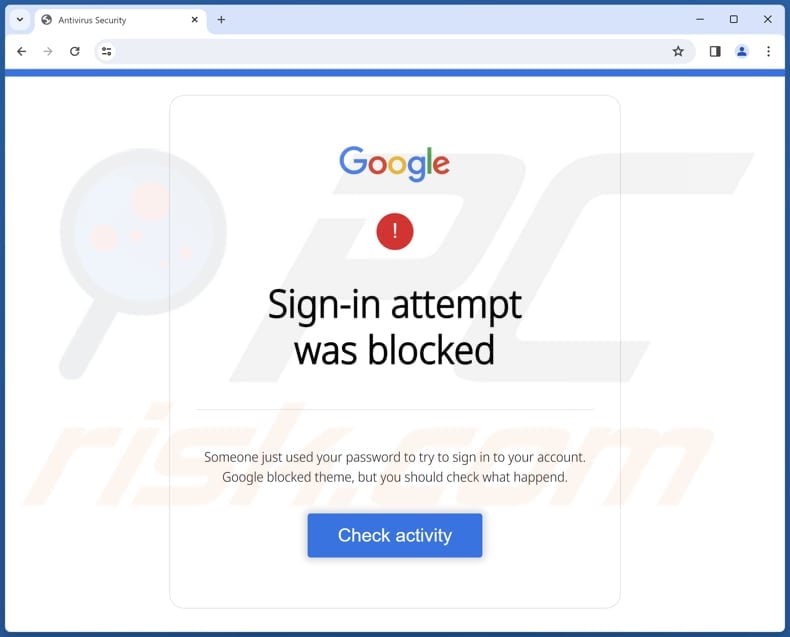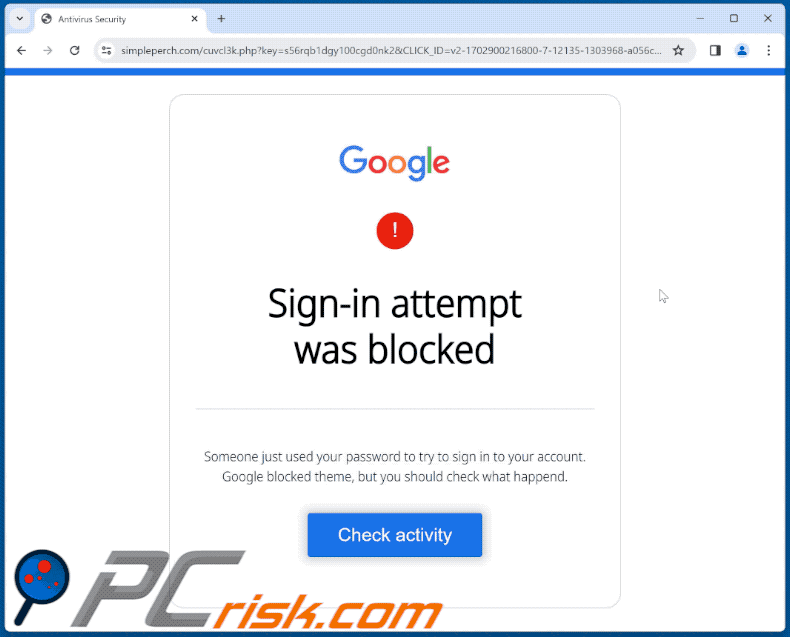How to avoid falling for schemes like "Google - Sign-in Attempt Was Blocked"
Phishing/ScamAlso Known As: Google - Sign-in Attempt Was Blocked scam
Get free scan and check if your device is infected.
Remove it nowTo use full-featured product, you have to purchase a license for Combo Cleaner. Seven days free trial available. Combo Cleaner is owned and operated by RCS LT, the parent company of PCRisk.com.
What is "Google - Sign-in Attempt Was Blocked"?
Following an examination, it has come to light that this is a deceitful scheme centered around a fraudulent notification regarding an unforeseen login. The primary objective of this fraudulent activity is to endorse a genuine software product. Nevertheless, the tactics employed for its promotion are deceptive and unethical.

"Google - Sign-in Attempt Was Blocked" in detail
The message in this scheme attempts to create a sense of urgency and concern by posing as a security alert from Google. It claims that a sign-in attempt using the user's password was blocked, implying potential unauthorized access to their account. The urgency is heightened by the suggestion that the user should investigate the incident immediately by clicking on the provided link labeled "Check activity".
If users click the "Check activity" link, they are redirected to a deceptive webpage that mimics a McAfee antivirus scan. The fake scan is intended to appear as a legitimate security check. The goal is to lead users to an affiliate link where the fraudulent affiliates earn a commission for every user who makes a purchase.
Ultimately, the scheme aims to deceive users by leveraging the trust associated with reputable brands like McAfee while exploiting the fear of a potential security threat. It is crucial for individuals to be vigilant and verify the authenticity of such messages before taking any action.
It is important to note that scams of this kind can be designed to extract a range of sensitive information, including personal details like names, addresses, and contact information, as well as login credentials such as usernames and passwords. These deceptive schemes may also target financial data, such as credit card numbers and bank account information, posing a risk of identity theft or fraudulent transactions.
| Name | Google - Sign-in Attempt Was Blocked scam |
| Threat Type | Phishing, Scam, Social Engineering, Fraud |
| Fake Claim | Google has blocked an unforseen login |
| Disguise | Notification from Google |
| Related Domain | simpleperch[.]com |
| Detection Names (simpleperch[.]com) | N/A (VirusTotal) |
| Symptoms | Fake error messages, fake system warnings, pop-up errors, hoax computer scan. |
| Distribution methods | Compromised websites, rogue online pop-up ads, potentially unwanted applications. |
| Damage | Loss of sensitive private information, monetary loss, identity theft, possible malware infections. |
| Malware Removal (Windows) |
To eliminate possible malware infections, scan your computer with legitimate antivirus software. Our security researchers recommend using Combo Cleaner. Download Combo CleanerTo use full-featured product, you have to purchase a license for Combo Cleaner. 7 days free trial available. Combo Cleaner is owned and operated by RCS LT, the parent company of PCRisk.com. |
Similar scams in general
Pages used by fraudulent affiliates typically employ sophisticated design elements and mimic the appearance of legitimate websites associated with reputable brands. They often feature simulated security scans, urgent messages, and alarming pop-up notifications to create a sense of urgency and concern.
As a rule, their goal is to trick users into making a purchase. Also, these pages may be created to trick users into downloading software or providing personal information under the guise of resolving a purported issue.
A couple of examples of sites promoting legitimate products in deceptive ways are discoverpcpotential[.]com, lifebestconcept[.]com, and unknownfundamentals[.]com.
How did I open a scam website?
Users often get tricked into visiting fraudulent affiliate pages through deceptive emails, messages, or online advertisements. Pages that use rogue advertising networks (e.g., illegal movie streaming sites and torrent pages) are also employed to promote shady web pages.
In other cases, users land on such pages via ads displayed by installed adware (or similar software) or notifications shown by unreliable sites. Either way, users rarely visit such sites on purpose.
How to avoid visiting scam pages?
Be skeptical of unsolicited emails and messages. If a message or email seems suspicious, refrain from clicking on embedded links. Instead, visit the official pages directly by typing the URL into your browser. Avoid interacting with ads and pop-ups on questionable websites or notifications from sites of this kind.
Download apps from official pages and stores and remove suspicious programs that have already been installed. Regularly update your browser, other apps, operating system, and security software. Employ a reputable antivirus or anti-malware program.
If your computer is already infected with unwanted apps, we recommend running a scan with Combo Cleaner Antivirus for Windows to automatically eliminate them.
The appearance of "Google - Sign-in Attempt Was Blocked" pop-up scam (GIF):

Text on this page:
Sign-in attempt was blocked
Someone just used your password to try to sign in to your account.
Google blocked theme, but you should check what happend.[Check activity]
Instant automatic malware removal:
Manual threat removal might be a lengthy and complicated process that requires advanced IT skills. Combo Cleaner is a professional automatic malware removal tool that is recommended to get rid of malware. Download it by clicking the button below:
DOWNLOAD Combo CleanerBy downloading any software listed on this website you agree to our Privacy Policy and Terms of Use. To use full-featured product, you have to purchase a license for Combo Cleaner. 7 days free trial available. Combo Cleaner is owned and operated by RCS LT, the parent company of PCRisk.com.
Quick menu:
- What is Google - Sign-in Attempt Was Blocked scam?
- How to identify a pop-up scam?
- How do pop-up scams work?
- How to remove fake pop-ups?
- How to prevent fake pop-ups?
- What to do if you fell for a pop-up scam?
How to identify a pop-up scam?
Pop-up windows with various fake messages are a common type of lures cybercriminals use. They collect sensitive personal data, trick Internet users into calling fake tech support numbers, subscribe to useless online services, invest in shady cryptocurrency schemes, etc.
While in the majority of cases these pop-ups don't infect users' devices with malware, they can cause direct monetary loss or could result in identity theft.
Cybercriminals strive to create their rogue pop-up windows to look trustworthy, however, scams typically have the following characteristics:
- Spelling mistakes and non-professional images - Closely inspect the information displayed in a pop-up. Spelling mistakes and unprofessional images could be a sign of a scam.
- Sense of urgency - Countdown timer with a couple of minutes on it, asking you to enter your personal information or subscribe to some online service.
- Statements that you won something - If you haven't participated in a lottery, online competition, etc., and you see a pop-up window stating that you won.
- Computer or mobile device scan - A pop-up window that scans your device and informs of detected issues - is undoubtedly a scam; webpages cannot perform such actions.
- Exclusivity - Pop-up windows stating that only you are given secret access to a financial scheme that can quickly make you rich.
Example of a pop-up scam:

How do pop-up scams work?
Cybercriminals and deceptive marketers usually use various advertising networks, search engine poisoning techniques, and shady websites to generate traffic to their pop-ups. Users land on their online lures after clicking on fake download buttons, using a torrent website, or simply clicking on an Internet search engine result.
Based on users' location and device information, they are presented with a scam pop-up. Lures presented in such pop-ups range from get-rich-quick schemes to fake virus scans.
How to remove fake pop-ups?
In most cases, pop-up scams do not infect users' devices with malware. If you encountered a scam pop-up, simply closing it should be enough. In some cases scam, pop-ups may be hard to close; in such cases - close your Internet browser and restart it.
In extremely rare cases, you might need to reset your Internet browser. For this, use our instructions explaining how to reset Internet browser settings.
How to prevent fake pop-ups?
To prevent seeing pop-up scams, you should visit only reputable websites. Torrent, Crack, free online movie streaming, YouTube video download, and other websites of similar reputation commonly redirect Internet users to pop-up scams.
To minimize the risk of encountering pop-up scams, you should keep your Internet browsers up-to-date and use reputable anti-malware application. For this purpose, we recommend Combo Cleaner Antivirus for Windows.
What to do if you fell for a pop-up scam?
This depends on the type of scam that you fell for. Most commonly, pop-up scams try to trick users into sending money, giving away personal information, or giving access to one's device.
- If you sent money to scammers: You should contact your financial institution and explain that you were scammed. If informed promptly, there's a chance to get your money back.
- If you gave away your personal information: You should change your passwords and enable two-factor authentication in all online services that you use. Visit Federal Trade Commission to report identity theft and get personalized recovery steps.
- If you let scammers connect to your device: You should scan your computer with reputable anti-malware (we recommend Combo Cleaner Antivirus for Windows) - cyber criminals could have planted trojans, keyloggers, and other malware, don't use your computer until removing possible threats.
- Help other Internet users: report Internet scams to Federal Trade Commission.
Frequently Asked Questions (FAQ)
What is a pop-up scam?
A pop-up scam is a deceptive technique where fraudulent pop-up windows appear on a user's screen, often while browsing the internet. These pop-ups typically contain misleading information, fake alerts, or urgent messages aiming to trick users into taking certain actions.
What is the purpose of a pop-up scam?
These scams are employed to trick users into clicking on malicious links, downloading harmful software, providing personal information, etc. Also, they can be used to promote legitimate products or services in deceptive ways.
Why do I encounter fake pop-ups?
Scams are often promoted through various channels, including deceptive emails, fake websites, online ads (including notifications from dubious sites), and social media. It is uncommon for users to open scam websites on purpose. Typically, they get tricked into it.
Will Combo Cleaner protect me from pop-up scams?
Combo Cleaner can scan each website you visit, effectively identifying and detecting malicious ones. This includes websites designed to propagate pop-up scams, ensuring you receive immediate warnings and restricting access to such deceptive sites.
Share:

Tomas Meskauskas
Expert security researcher, professional malware analyst
I am passionate about computer security and technology. I have an experience of over 10 years working in various companies related to computer technical issue solving and Internet security. I have been working as an author and editor for pcrisk.com since 2010. Follow me on Twitter and LinkedIn to stay informed about the latest online security threats.
PCrisk security portal is brought by a company RCS LT.
Joined forces of security researchers help educate computer users about the latest online security threats. More information about the company RCS LT.
Our malware removal guides are free. However, if you want to support us you can send us a donation.
DonatePCrisk security portal is brought by a company RCS LT.
Joined forces of security researchers help educate computer users about the latest online security threats. More information about the company RCS LT.
Our malware removal guides are free. However, if you want to support us you can send us a donation.
Donate
▼ Show Discussion